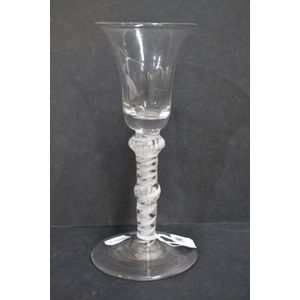Georgian Wine Glass with Baluster Stem and Bucket Bowl
You must be a subscriber, and be logged in to view price and dealer details.
Subscribe Now to view actual auction price for this item
When you subscribe, you have the option of setting the currency in which to display prices to $Au, $US, $NZ or Stg.
- Baluster (glass) - An architectural term for a column in a balustrade or staircase.
When used to describe glass, it can either refer to the shape of the stem of a wine glass, being slender above and pear shaped below, or the shape of the whole vessel, usually a vase. In fact the baluster shape is often described as being vase-like.
The description of a vase as being of baluster shape covers a wide variety of shapes that often bear no resemblance to the original architectural form. - Bowl - With drinking glasses, the bowl is the hollow section of the glass that holds the liquid. Many glasses were mounted on a stem joined to a foot, others were cylindrical, of tumbler shape. The size and shape of the bowl was determined by the type of liquids they were meant to hold. Shapes used included bell shaped, conical (funnel), bucket shaped, trumpet, cup, ogee, funnel, cylindrical and rounded.
- Georgian - As an English stylistic period, Georgian is usually taken to cover the period from George I (1714) to the Regency of Prince George (1811-20), although the period from 1800 to 1830 is sometimes designated as the Regency period. During the Georgian period the great English cabinetmakers and designers such as Chippendale, Hepplewhite, Adam Sheraton etc., were all active.
Therefore there isn't a single 'Georgian style' as such and to say something is 'Georgian', usually means it was made between 1714 and 1830. This assumes we discount George V and George VI, both being from the 20th century.
The styles popular at the time of each reign were:
George I (1714-1727) saw out the last years of the Baroque period.
George II (1727-1760) reigned during the Rococo period.
George III (1760-1820) saw the last gasp of the Rococo, all of the early Neo-Classic 'Adam style' and most of the later neo-Classic 'Regency style'.
George IV (Prince Regent 1820-1830)encompassed the last of the 'Regency' style.
William IV's reign (1830-1837) was something of a no man's land (stylistically) and he wasn't a 'George' anyway. He covered the last glimmerings of 'Regency' and the start of the 'Victorian' style. - Stem - In drinking glasses the stem is that section of the glass that joins the bowl to the foot. In mass produced glasses is usually solid and of cylindrical shape, but in antique drinking glasses it may be long and short and in various styles or with decoration, such as air twist, baluster, collared, faceted, hollow, knopped, teardrop, twisted or incised.
This item has been included into following indexes:
Visually similar items

A late Georgian bobbin stem engraved cordial glass, circa 1830, with a rose and foliage engraved trumpet bowl above a four knop bobbin stem to a conical foot, with a lightly polished pontil. Height 14.5 cm

A George II plain stem Balustroid wine glass, circa 1740, the bell shaped bowl with a tapering stem to a conical fold over foot with a rough pontil, with various trapped bubbles and impurities including one significant 'Stone' to the bowl. Height 15.5 cm

A Georgian wine glass, circa 1750 the bell form bowl engraved with roses, the composite multiple air twist stem with shoulder and basal knop, supported on a plain foot, 17 cm high

Georgian cotton twist stem glass
